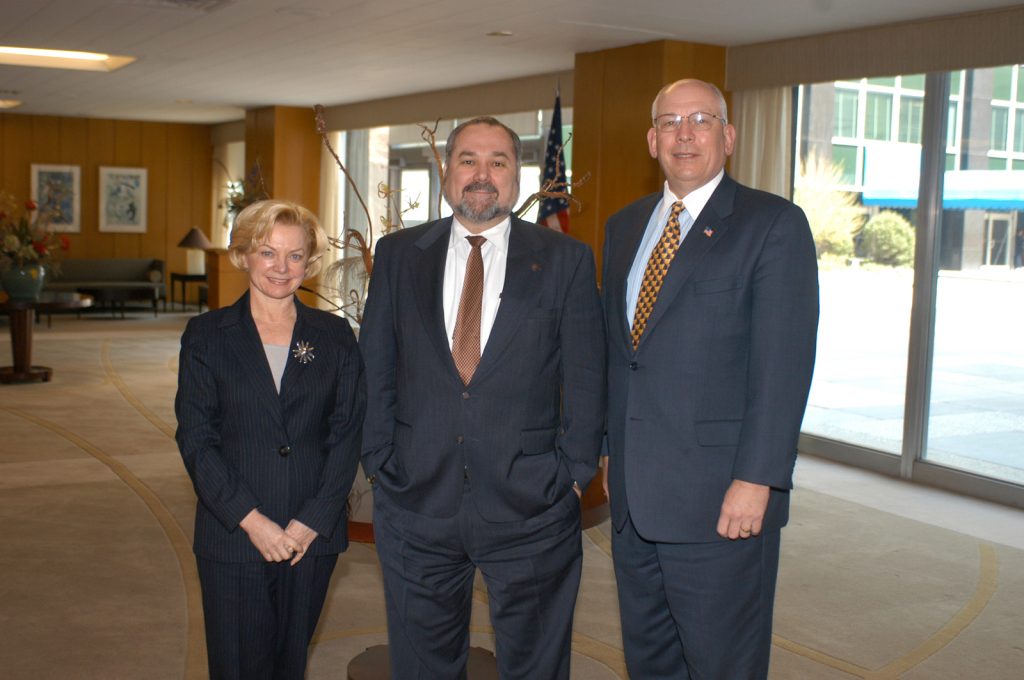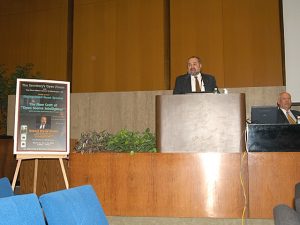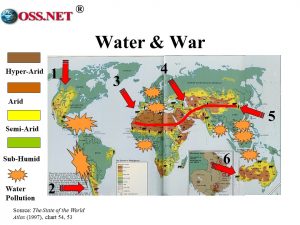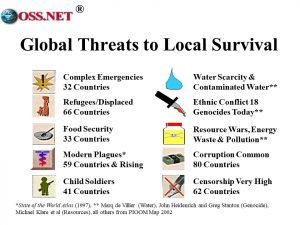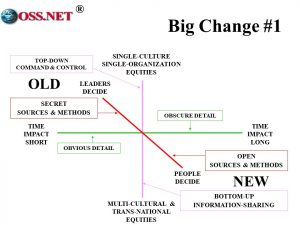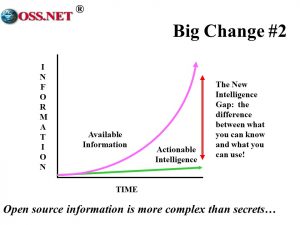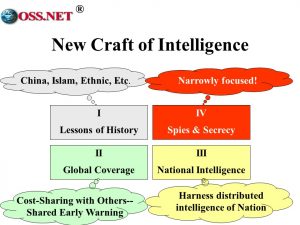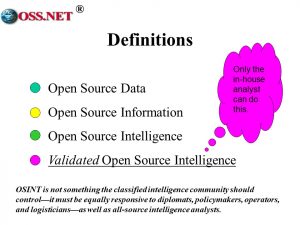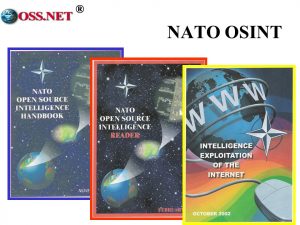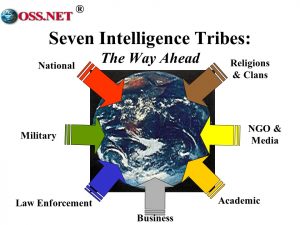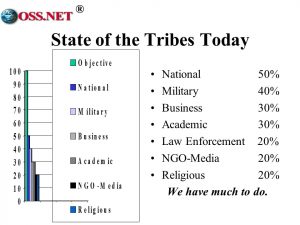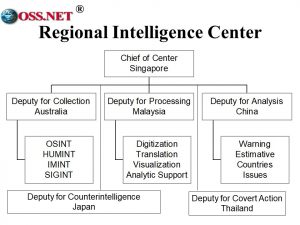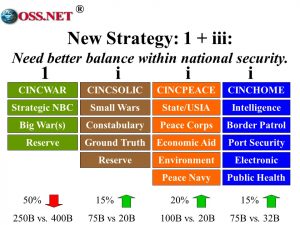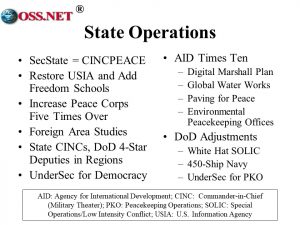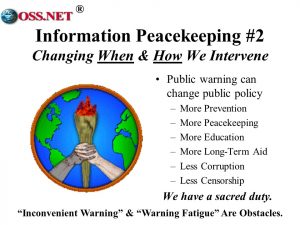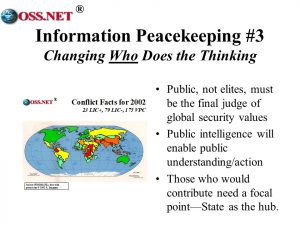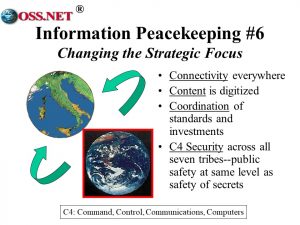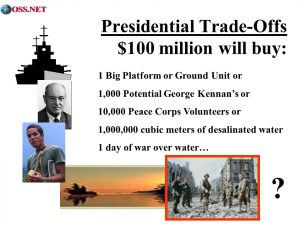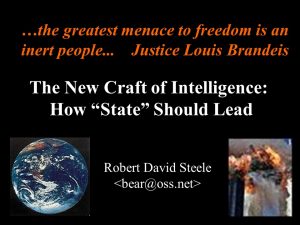Graphics and Script in Full Text Below the Fold
- PDF (42 Pages): 2004 Steele Briefing to State Main Auditorium.docx
- Representative Questions & Answers Following State Speech
- Office Department of State Transcript of Steele 24 Mar 04 (Includes FBIS Comment)
I’m here to talk about the New Craft of Intelligence. I am a recovering spy—although I was good at it, I was stunned to learn, while creating the Marine Corps Intelligence Command, that 85% or so of what we need to know is not secret, not in English, not online, and not known to anyone inside the beltway. I looked into this, and in my second graduate thesis, studying three Embassies, discovered that we collect less than 10% of what can be known that is relevant to our interests, and we spill 80% of that in sending it back via pouch. Washington is operating on 2% of reality.
There is such a thing as evil in the world and people willing to perpetuate it. That’s the sad reality.
However, there is another reality, and that is the reality of a mismatch between what we need in the way of national security and international affairs capabilities, and how we actually spend $500 billion a year in taxpayer dollars.
No one present needs to be told that the challenges facing us are great, but I will quickly survey the landscape, and then outline my vision for saving America through applied national intelligence led by you—by State.
 In the mid-1980’s, as one of the first case officers assigned to the terrorist target full time, I told the National Intelligence Officer for Terrorism that we were too dependent on foreign liaison. That is still true today. All that is wrong with national intelligence and national policymaking is well known and has been well known for 10-15 years. We’ve shut out reality.
In the mid-1980’s, as one of the first case officers assigned to the terrorist target full time, I told the National Intelligence Officer for Terrorism that we were too dependent on foreign liaison. That is still true today. All that is wrong with national intelligence and national policymaking is well known and has been well known for 10-15 years. We’ve shut out reality.
That said, I am focused on the future. We don’t need to cast blame. More than anything we need to change our mind-sets about who does what—for example, who leads intelligence for America—you, not the DCI.
Nation states are only ten percent of the threat. More threatening are private sector organizations that destroy people’s life savings or export their jobs, or that implant immoral capitalism abroad, enriching elites and disenfranchising all others; ethnic criminal gangs such as we see coming out of Russia, China, Vietnam, Korea, Japan, and Colombia; and bacteria.
Finally, we have Mother Earth, on the verge of collapse. The Earth is tired of our talk, wants peace, an end to promises, and perhaps an end to us. [Philip Levine, 1979]
 We are spending as much on national defense as Russia, China, the axis of evil countries, and the next 20 governments all put together.
We are spending as much on national defense as Russia, China, the axis of evil countries, and the next 20 governments all put together.
We are spending too much on a heavy-metal military and secret technical satellites, and not enough on salaries for our Armed Forces, on human experts including diplomats, on technical processing, on state & local intelligence, and on public health and clean water supplies.
I’m not here to be critical, only to point out that this is our starting point. The good news is that there is plenty of money for new ideas. We just have to cut funding for the bad old ideas.
This is the reality that we are not ready to deal with as we are now structured and funded.
We have a world that is largely unstable and at war with itself.
In 2002 there were 23 conflicts killing over 1000 people a year, 79 killing under 1000 a year, and 175 violent political conflicts internal to a specific country.
Neither the CIA nor the media articulate this reality to our public. You must take up this challenge.
It gets worse. Everyone knows about the Holocaust against those of the Jewish faith during World War II.
What most people do not realize is that there have been over 70 genocides in history, and that there are 18 genocides taking place today as we gather here to consider national security and the future of America.
How we understand and deal with genocide today is a litmus test of our national competence.
These ethnic conflicts tend to coincide with conditions of severe deprivation.
Note the red line—some of the worst water scarcity and some of the worst ethnic conflicts are along the Russian borders with both the Islamic states of Central Asia, and the Chinese state…and of course between Israel and Palestine.
Water scarcity is a national security threat that does not receive enough attention. It has troubling potential here at home.
These ethnic conflicts tend to coincide with conditions of severe deprivation.
Note the red line—some of the worst water scarcity and some of the worst ethnic conflicts are along the Russian borders with both the Islamic states of Central Asia, and the Chinese state…and of course between Israel and Palestine.
Water scarcity is a national security threat that does not receive enough attention. It has troubling potential here at home.
We are also very vulnerable at home. We built our great society on the assumption that there might be occasional acts of God, but never on the assumption that suicidal terrorists would be willing to blow up tunnels, bridges, pipelines, apartment buildings, dams, or banking centers.
Our economy, our data, our public health are all hostage to the possibility of suicidal terrorists. Our existing national security capabilities are simply not effective against this threat. The water’s edge is not a defensive shield. We must eliminate global instability precisely because we are so vulnerable locally.
As I discuss in my second book, copies of which are in your library, the real world presents America with four distinct threats, each completely different, each requiring completely different national security capabilities.
Three of these four threat classes require very big investments in peaceful preventive measures and in human expertise.
That’s where you come in. It is time for State to get back in the business of grand strategy, inter-agency planning, and inter-agency operational campaign management.
We can start by acknowledging that what we have now, a vestige of the Cold War, is a poor investment for the future.
Evaluated against the real-world challenges, we quickly establish that our traditional defense capabilities are relevant only 10% of the time.
We need a strong national security program, but it must be a smart program that is relevant to the full range of real world threats.
We have started a six-front 100-year war.
In the near future, we not only have to dampen this down and extricate ourselves from 700+ military bases around the world, but we have to devise a thoughtful plan for eliminating dictators, nurturing legitimate governments, stabilizing and then reversing deforestation and desertification, destroying ethnic criminal gangs and terrorist networks, and controlling corporate crime and corruption, including tax avoidance.
Tough challenges. Your role is important.
We need to change how we manage our international affairs and national security, including our economic competitiveness.
We do this with a single integrated policy staff that can trade-off and manage ways, means, & ends across domestic and foreign programs.
We also need a modern intelligence community that places greater emphasis on open sources of information, while identifying $20 billion per year in savings from waste in the classified “community” as it is erroneously called. The Global Knowledge Foundation is yours to lose. Take the lead on OSINT or lose this to DoD.
A modern president must understand the importance of strategic thinking, and will create a strategic staff that is able to manage inter-agency responses to complex problems, and also able to plan longer-term campaigns that are in the best interests of the American people.
State used to be the center of policy planning and grand strategic thinking. We must restore those talents, both at State and within the White House.
Your diplomatic skills matter more today, and will be priceless tomorrow, because the paradigm for international affairs has changed. Arrogant sovereignty and top-down unilateral decisions are history….with the occasional neo-conservative exception.
The future is here now, and it is about bottom-up multi-cultural decisions that are based primarily on shared open sources of information, not secrets, and that focus specifically on achieving sustainable long-term agreement.
Big Change # 1 combines with Big Change #2 to present an information explosion challenge that no one nation, much less any one “central intelligence” organization, can cope with.
We spend $30 to 50 billion going after the small amount of relevant information that we can steal—when we can find it—and we spend virtually nothing addressing the universe of information that is legally and ethically available in 29+ languages and as many again dialects.
Our national security program must be an informed program. I am quite serious when I suggest that Washington is operating on 2% of the relevant multi-lingual information.
We must create a Smart Nation that respects the lessons of history in all languages; creates cost sharing networks with other nations; harnesses the distributed intelligence in our private sector; and focuses a revitalized spy service narrowly, deeply, and effectively.
I believe we can double or triple what can be known, relatively quickly, at a cost of less than $125 million in year one.
With that as preamble, I will now spend a few minutes discussing Open Source Intelligence.
First, we must distinguish between data—the raw sources in many languages and mediums—information that collates data for generic audiences—and intelligence, which is tailored to the needs of a specific decision-maker. Intelligence is about supporting decisions, not about secret sources.
Second, I would emphasize that OSINT should not be controlled by the spies. Ideally we should have an independent agency that is equally responsive to all elements of government.
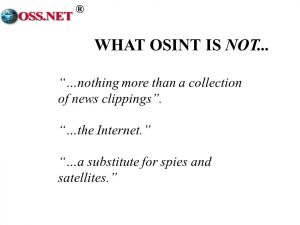 I have been working this issue for over 14 years now, and I have learned that there are some common misconceptions about OSINT among the most senior diplomats and other policymakers and operators.
I have been working this issue for over 14 years now, and I have learned that there are some common misconceptions about OSINT among the most senior diplomats and other policymakers and operators.
Here you see what OSINT is not.
At its best, OSINT is the complete marriage of the proven process of intelligence, from requirements definition and collection management to timely analytics, with all—and I do mean all—legally and ethically available sources.
It is important to emphasize the paucity of those endeavors that are limited to English or the main European languages. If one cannot work in 29+ languages on a 24/7 basis—that is, in near-real-time, one is not serious.
Print and broadcast media are actually the smallest part of the open source universe. Untapped perceptions, oral histories, informal exchanges, limited edition local publications, pre-prints, and geospatial as well as imagery information of all kinds—including photos from cells phones with geospatial positioning system information—this is the larger universe.
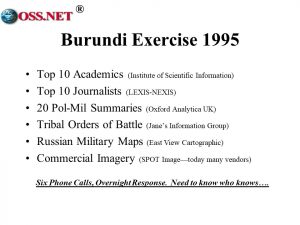 Lest you might believe that the U.S. Government does OSINT, but does not advertise, I will simply highlight the fact that in August 1995, in an overnight exercise, I defeated the entire U.S. Intelligence Community—all agencies—in what is now known as the Burundi exercise.
Lest you might believe that the U.S. Government does OSINT, but does not advertise, I will simply highlight the fact that in August 1995, in an overnight exercise, I defeated the entire U.S. Intelligence Community—all agencies—in what is now known as the Burundi exercise.
I did this with six telephone calls on my way to the airport. It was not a fair contest—if you believe that only secrets matter, then you will tend to not know where to go for the non-secrets. There has been no real change since then due to persistent opposing mind-sets.
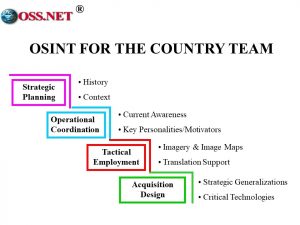 This is the slide that got General Peter Schoomaker, then Commander in Chief of the Special Operations Command, and today the Chief of Staff of the Army, to believe that OSINT could make a difference.
This is the slide that got General Peter Schoomaker, then Commander in Chief of the Special Operations Command, and today the Chief of Staff of the Army, to believe that OSINT could make a difference.
To his credit, today the U.S. Special Operations Command is the only element of the U.S. Government that is completely proficient in what I call operationally-oriented OSINT—from monitoring terrorist and insurgent web sites in 29 languages, to tribal studies to acquisition studies to Russian military maps integrated with US shuttle mission terrain elevation data, they get it.
NATO also gets it. Under the leadership of another great Army general, William Kernan, NATO, when it began expanding, adopted OSINT as its standard for establishing common understandings with Partnership for Peace nations and other coalition partners of the moment, including non-governmental organizations.
As of this minute, these three publications, all available free on the Internet, represent the standard of excellence for OSINT.
Now let me dig a little deeper and explore some of the nuances of the open source world.
We achieve new efficiencies and effectiveness in national intelligence—and in our international affairs—by recognizing that there are seven tribes relevant to our planning and to our operations.
We must nurture these seven tribes, in part by recognizing them, in part by training them, and in part by developing generic standards for migrating the proven process of intelligence from the spy world to the open world. That’s where you come in—only you can do this.
There is plenty of room for improvement on all fronts. This is my considered judgment on where we are today. My first book evaluates the U.S. Intelligence Community in great detail, and ends with a 62-page index.
Don’t ever be intimidated by a spy claiming to know things you do not know. The problem with spies is they only know secrets—they only believe in what can be stolen, not what can be known.
It is you, as diplomats, who can bring these seven tribes together, and nurture a new form of national intelligence.
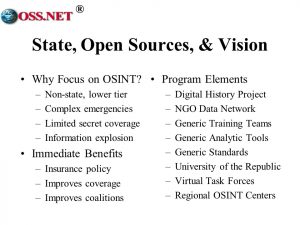 Never in our history have we been more in need of a professional OSINT endeavor, and I believe that you here in State should provide the leadership.
Never in our history have we been more in need of a professional OSINT endeavor, and I believe that you here in State should provide the leadership.
OSINT can cover everything the spies cannot focus on. It provides an insurance policy. It can be shared with anyone. Best of all, it puts State back in charge of foreign affairs.
I have posted a detailed budget at OSS.Net, developed for the Senate Armed Services Committee, showing precisely how I would spend $125M a year—on the way to $1.5B a year—to revitalize America’s intelligence.
I created our Nation’s newest all-source intelligence center from 1988 to 1992. I have served in three of the four Directorates at CIA, and I understand the real world and what can be known about the real world.
I’m here to tell you that the US Government, on its own, with all the money in the world to spend, will never in a million years get it right.
We must—we must—lead the way in creating regional intelligence centers that share the burden and leverage local access and local knowledge. From OSINT we can graduate to multinational clandestine and shared technical operations—but first we have to do OSINT.
 Let me jump from that to the current discussion of the need for a European intelligence agency.
Let me jump from that to the current discussion of the need for a European intelligence agency.
Europe, like America, must deal with decades of lax control over immigration and citizenship —terrorists have US & European passports.
EUROPOL is not up to this challenge, and I do not believe that any kind of centralized pan-European agency will be effective either. Instead, I believe that Europe must create a network, with standards and templates for sharing information, not just between governments, but with the private sector. It is my hope Europe will do something brilliant.
Now let’s discuss money. A proper national intelligence endeavor, relying predominantly but not exclusively on open sources, should conclude that we cannot cut the national security budget, but that we should create four forces corresponding to the four major threat types.
Big War can go down to $250 billion a year. Small war, including Ambassador Bob Oakley’s gendarme and an armed “white hat” capability, goes up to $75B. State should get $100B a year more to do peace. Homeland security needs to go up to $75B, half at the federal level, the other half at the state and local levels, to create full-blown intelligence centers and professional cadres of intelligence and counterintelligence specialists at the local level.
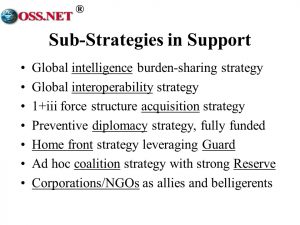 Beyond four forces, we need some sub-strategies.
Beyond four forces, we need some sub-strategies.
–a global intelligence burden-sharing strategy
–a global interoperability strategy
–an acquisition strategy that respects the differences between the four forces after next
–a fully-funded preventive diplomacy & aid strategy;
–a home front strategy that completely remakes both the National Guard & the Coast Guard
–a coalition strategy using a strong Reserve to maximize foreign area and non-traditional skills on demand;
and lastly, not a sub-strategy, but simply a doctrinal recognition, of corporations and NGOs as both potential allies, and potential belligerents and therefore as legitimate targets for intelligence, especially open source intelligence.
The OSINT budget will permit State to make a compelling case for the 1+iii strategy.
SecState, as Commander-in-Chief for Peace Operations, should be spending an additional $100B a year. The regional theaters should become interagency commands led by men of the caliber of Ambassador Bob Oakley, with four-star military deputies. I agree with Ambassador Palmer about an Undersecretary focused on eliminating dictators, and I want a corresponding Undersecretary of Defense focused on Peacekeeping Operations designed and led by State.
In summary,State should become America’s foremost intelligence organization, because it alone can orchestrate both a national and a global network of legal and ethical open sources that provide 85% to 90% of all that can and need to be known.
Done properly, State should be able to change what we spend the taxpayer’s money on.
State should also be able to change when and how we intervene.
The major problem with secret warning is that it can be safely ignored without alarming the public.
Secret intelligence is not actionable intelligence in the public diplomacy or public security senses of the word.
State, with OSINT, can warn America in a compelling manner that cannot be manipulated nor disregarded.
State can influence who does the thinking.
There are 1,400 professors across America who specialize in Middle Eastern matters and are not consulted by Washington. An equal number are resident in other countries.
By harnessing the distributed intelligence of the Nation, and of the Whole Earth, State can ensure that we avoid the cancer of secret intelligence, mirror imaging.
Indeed, by providing leadership and structure, State can help create a Smart Nation, a World Brain, and a framework for public intelligence.
With State leadership, we can change how we make a difference, leveraging all seven tribes.
Faith-based diplomacy can be quite dangerous—witness the combination of Texas evangelicals and Zionist zealots focused on spawning the perfect Red Calf—or it can be quite constructive.
Journalists, academics, business professionals, non-governmental organizations—they are all acting now in isolation, based on limited information. We can offer them all a voluntary framework for collaboration in the sharing of legal and ethical information.
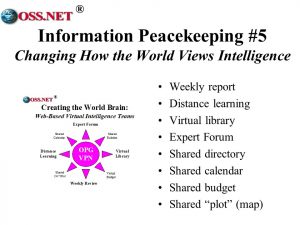 We are making progress at the United Nations, aided in part by the Brahimi Report and by our new book. Intelligence can nurture peace.
We are making progress at the United Nations, aided in part by the Brahimi Report and by our new book. Intelligence can nurture peace.
Intelligence is not about secret methods. It is about a process for methodically collecting, processing, analyzing, and acting on all that can be known. It is decision-support.
We will always need and must honor the value of secret intelligence. However, State should leap at this opportunity to embrace an old mission in a new world: it’s about knowing. It is about sharing. It is about informed consensus and sustainable overt action.
Finally, it makes sense for State, which is responsible for our foreign relations, to change the strategic focus of American intelligence, American defense, American strategy, and American spending.
In the age of distributed information, central intelligence is an oxymoron. Only State has the global access, the international confidence, the intellectual savoir faire, and the emotional balance to connect the world, to lead a global campaign to digitize all knowledge, to coordinate international standards and investments, and to respect the role that security plays in assuring privacy & safety.
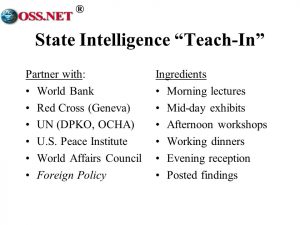 I would like to see all of you learn more.
I would like to see all of you learn more.
The World Bank would be the ideal partner, because with help from my friend Steve Denning, they have realized that they are in the knowledge business, not the lending business. I believe that nothing could be more salutary than a State-sponsored intelligence “fair”, a one-day all-hands stand-down, in which the World Bank and a few other select partners are invited to explore this amazingly fertile, amazingly responsive, and amazingly inexpensive world of Open Source Intelligence, or OSINT. You should lead!!
This is the bottom line. Today intelligence has absolutely nothing to do with major decisions about how the U.S. taxpayer dollar is spent.
Intelligence is not relevant because we have not learned how to do OSINT and make a compelling public case for “trade-offs.”
This is what $100M can buy—a warship or large ground unit with tanks and artillery—or 1000 diplomats—or 10,000 Peace Corps volunteers—or a water desalination plant—or one day of war over water.
The same contrasts exist with respect to terrorism, poverty, disease, and dictatorships.
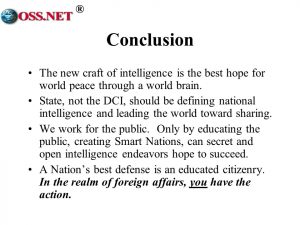 With all humility, at the end of fourteen years of wandering in the wilderness of open sources, helping over 40 governments and over 6,000 intelligence professionals get in touch with open sources, I am convinced that the New Craft of Intelligence is the best hope for world peace through a world brain. State, not the DCI, should lead this endeavor. The public—and through them, Congress—should be our primary consumer.
With all humility, at the end of fourteen years of wandering in the wilderness of open sources, helping over 40 governments and over 6,000 intelligence professionals get in touch with open sources, I am convinced that the New Craft of Intelligence is the best hope for world peace through a world brain. State, not the DCI, should lead this endeavor. The public—and through them, Congress—should be our primary consumer.
Thomas Jefferson had it right on education as a Nation’s best defense. In the realm of foreign affairs, that means that you have the action.
You, in the room, you in this Department, must restore your statutory responsibility—your primacy—in understanding and interpreting the real world to our citizens and our policy makers.
OSINT will help you do that.
Millions more will die before we get it right. There is no time to waste. We must start now.
Thank you.
RELATED:
2007 Steele @Amazon — Robert Speaks, Amazon Files Patents…. Movie, Graphics, Script
2017 Robert Steele: OSINT Done Right



